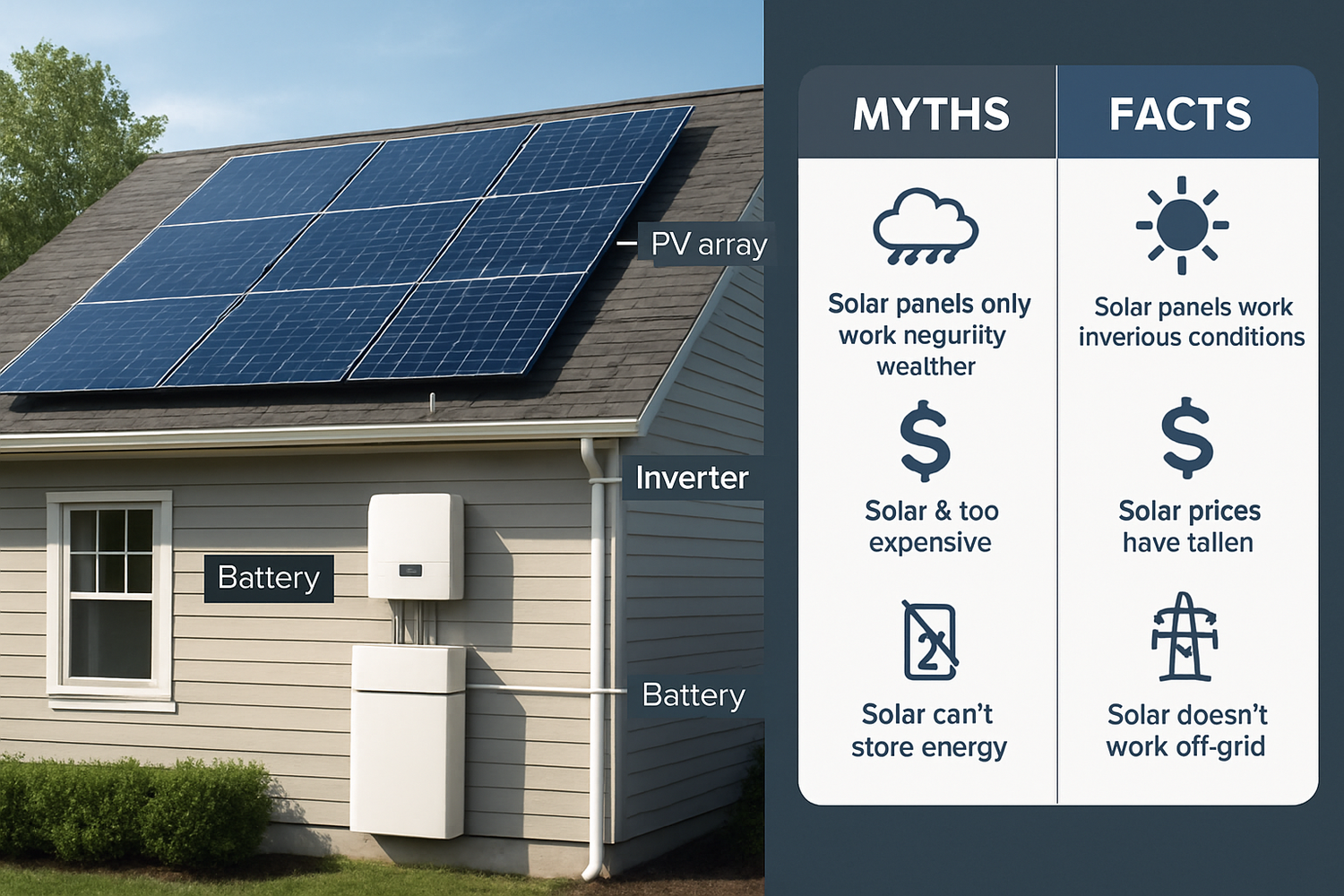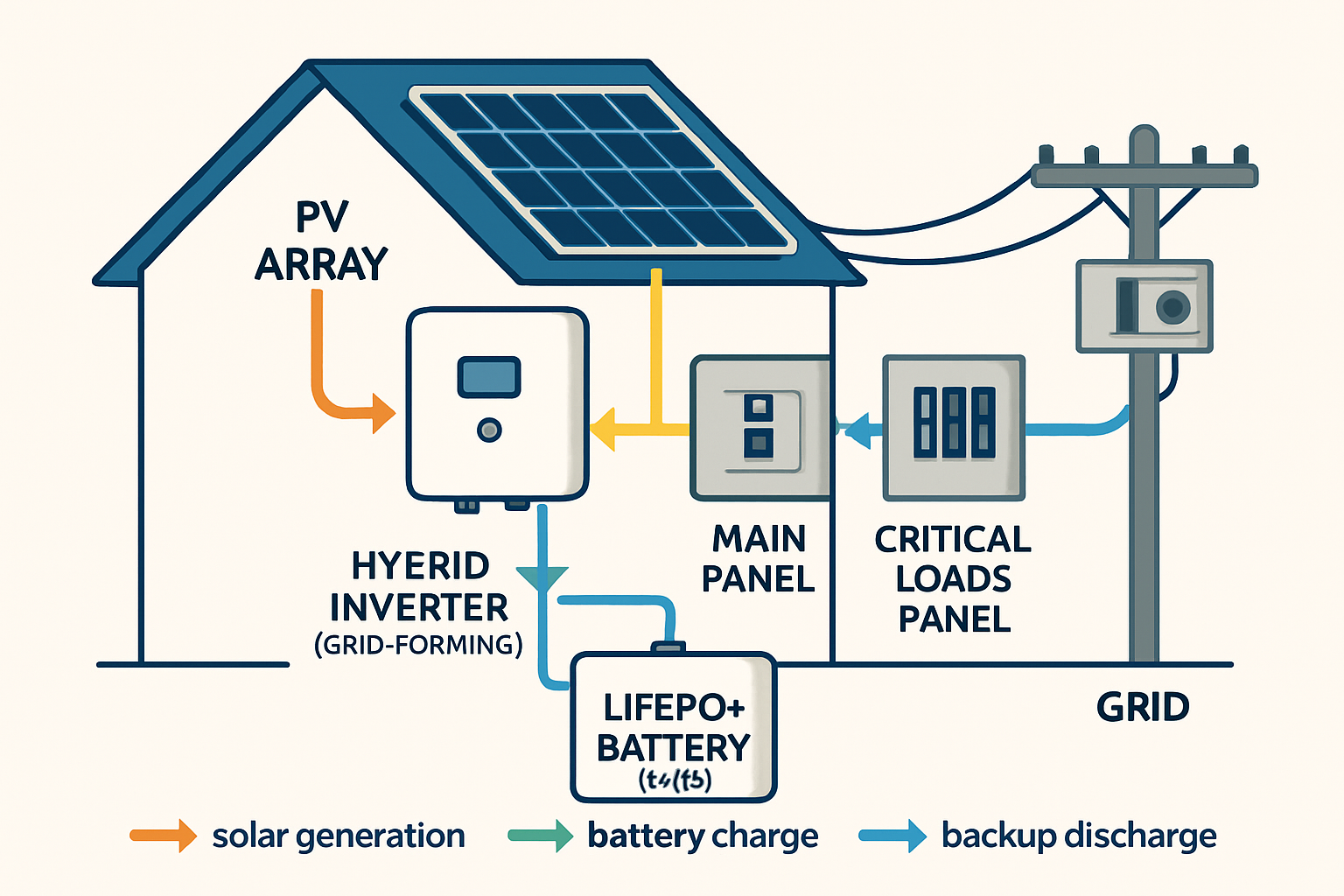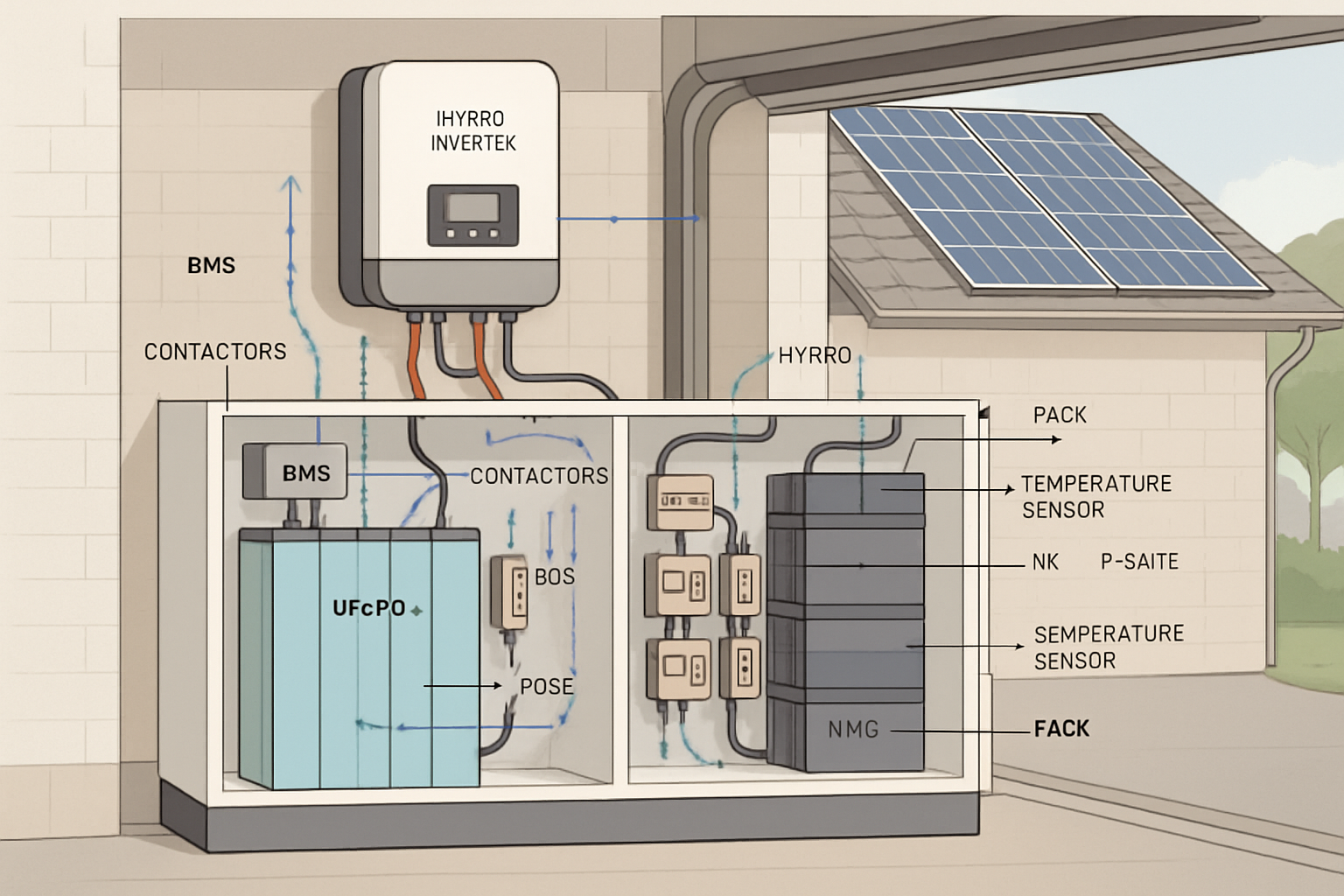Solar power attracts strong opinions, and myths often overshadow data. This piece separates solar energy facts from fiction. You will see how costs have dropped, why modern panels work in varied climates, what grid operators actually report, and how batteries fit in. Along the way, you’ll get practical tips for a residential solar installation and a clear solar myths vs facts comparison.

Why myths stick—and what data shows
Myths persist because energy systems are complex. Yet grid operators, public agencies, and independent researchers publish clear evidence. For example, at the end of 2020, installed U.S. solar capacity reached about 76 GW and generated roughly 3% of U.S. electricity, with significant room to grow, according to analyses summarized by Energy.gov and EIA. Integration challenges are real but manageable in stages, as outlined by the IEA’s Getting Wind and Solar onto the Grid. Costs keep improving, and soft-cost reforms are speeding residential adoption, as the U.S. Department of Energy’s Rooftop Solar Challenge highlights.
Myth 1: “Solar is too expensive for homes”
Fact: Hardware prices fell fast, and soft-cost reforms help
Module and inverter prices have dropped sharply in the past decade. In many markets, the non-hardware “soft” costs (permitting, interconnection, inspections, sales, and overhead) now represent a large share of residential system price. The U.S. DOE reported that soft costs can make up to 64% of total residential PV price and that streamlining cut permitting time by about 40% in targeted programs, reducing fees by over 10% for millions of potential adopters Energy.gov.
Local incentives, tax credits, and improved financing further reduce upfront outlays. Many households also add a battery to increase self-consumption and backup capability. We manufacture LiFePO4-based systems with long cycle life and stable chemistry to support that need, while remaining focused on safety.
- Actionable tip: Ask your installer for a line-item quote that separates hardware from soft costs. Push for online permitting and batch inspections where available.
- Actionable tip: Compare loan APR vs. cash discounts; include inverter replacement costs in your long-term math.
Myth 2: “Solar panels are inefficient and don’t work in cloudy or cold weather”
Fact: Efficiency is only part of the story; cold often helps
Modern monocrystalline panels commonly ship with 19–22% module efficiency. That is normal for commercial products and more than enough for rooftops. Performance depends on sunlight, shading, tilt, and temperature. Cooler air improves panel voltage, so cold, sunny days can be very productive.
Grid-scale and distributed photovoltaics are growing across a range of climates. Analyses summarized by Energy.gov show the U.S. added tens of gigawatts in the last decade across desert, coastal, and northern regions. Policy roadmaps by IEA and assessments by IRENA consistently show PV’s adaptability due to its modular nature.
- Actionable tip: Prioritize unshaded roof areas facing south (north in the Southern Hemisphere). Use module-level power electronics to limit shading losses.
- Actionable tip: Design tilt angles for annual yield unless you need a winter-biased profile.
Myth 3: “Solar destabilizes the grid and needs massive storage right away”
Fact: Grid integration happens in phases; early penetration is straightforward
The IEA describes four stages of variable renewable energy (VRE) integration. In the first stage, adding initial solar capacity has little noticeable impact on the system. As shares grow, operators adapt with forecasting, flexible generation, demand response, transmission upgrades, and storage—introduced in step with needs, not all at once.
U.S. decarbonization scenarios summarized by Energy.gov show solar expanding with storage, transmission, and load flexibility. The message: a smart mix of assets maintains reliability and cost control. EIA data also show that the current generation mix leaves large headroom for PV growth while retiring older, less flexible plants over time EIA.
- Actionable tip: For homes, a hybrid inverter plus a 5–20 kWh battery covers most outage needs and increases solar self-use.
- Actionable tip: In grid-tied systems without batteries, smart inverters support grid stability via voltage and frequency ride-through features.
Myth 4: “Solar is useless at night; batteries are risky or don’t last”
Fact: Storage bridges solar’s daily cycle; LiFePO4 offers stable performance
Solar produces in the day; storage shifts that energy to evenings and outages. In residential use, lithium iron phosphate (LiFePO4) batteries are popular due to thermal stability and long cycle life. Our ESS integrates LiFePO4 cells, a hybrid inverter, and monitoring for a compact footprint. Typical designs support 6,000+ cycles at moderate depth of discharge, which fits a 10–15 year duty profile for many homes.
Utility-scale analyses summarized by Energy.gov show storage deployment rising with PV, providing peak capacity, ramping support, and curtailment reduction in higher-penetration futures. This aligns with the IEA’s staged integration view IEA.
- Actionable tip: Size batteries to cover your critical evening load for at least one cycle (e.g., 5–10 kWh for lighting, fridge, Wi‑Fi, small HVAC zones).
- Actionable tip: Ensure the inverter can power your largest starting load (e.g., heat pump or well pump) and supports blackout operation.
Myth 5: “Panels need constant maintenance and don’t last”
Fact: Panels are durable; most attention goes to inverters
Most PV modules carry 20–25-year power warranties. Routine maintenance is light: visual checks, occasional cleaning in dusty areas, and firmware updates for inverters. Inverters typically have a shorter service life than panels, so plan for mid-life replacement or extended warranties. U.S. solar program materials hosted by Energy.gov emphasize durability and the role of soft-cost reforms to simplify upkeep for homeowners.
- Actionable tip: Keep modules clear of debris and ensure adequate rear ventilation.
- Actionable tip: Ask for a monitoring portal to track performance and detect issues early.
Myth 6: “Solar takes too much land and drains materials”
Fact: Siting is flexible; circular practices are advancing
Solar is unique in its modularity—rooftops, carports, brownfields, and utility-scale sites all contribute. Analyses summarized by Energy.gov show that future land needs are manageable relative to suitable disturbed lands and multi-use siting. Materials planning and recycling are priorities highlighted in assessments by IRENA. Policy signals and technology trends point toward lower material intensity per watt and growing end-of-life pathways.
- Actionable tip: Prefer rooftops and already-developed sites first. Use agrivoltaics or co‑location approaches where suitable.
- Actionable tip: Check take-back policies and recyclability with your installer.
Solar myths vs facts comparison
| Myth | What data says | Practical takeaway |
|---|---|---|
| Solar is too expensive | Soft costs can reach up to 64% of residential price; streamlining cut permitting time ~40% and fees >10% in programs Energy.gov | Push for online permitting; compare financing; focus on lifetime cost per kWh |
| Solar barely contributes | About 76 GW installed U.S. capacity and roughly 3% of generation in 2020, with headroom to grow Energy.gov EIA | Policy, costs, and grid upgrades support sustained growth |
| It destabilizes the grid | IEA shows phased integration; early stages have limited impact; measures scale with penetration IEA | Use forecasting, flexibility, and storage as shares rise |
| Panels don’t work in cold weather | PV voltage improves in cooler air; performance depends on irradiance, shading, and design Energy.gov | Optimize tilt and reduce shading; cold climates are suitable |
| Batteries are unsafe and short-lived | LiFePO4 chemistry is thermally stable with long cycle life; storage deployment increases with PV in scenarios Energy.gov | Select certified LiFePO4 systems; size for evening peaks and outages |
How to plan a residential solar installation
Step 1: Profile your load and roof
- Collect 12 months of bills. Note daily kWh and seasonal peaks.
- Check roof age and structure. Re-roof first if needed.
- Assess shading via a site survey or satellite tools. Aim for low annual shade loss.
Step 2: Size PV and decide on storage
- PV sizing: Start with annual kWh ÷ local specific yield (kWh/kW/yr). Adjust for roof space and budget.
- Battery sizing: Critical loads ÷ hours of coverage (e.g., 1.5 kW x 6 h ≈ 9 kWh). Add margin for inverter surge.
- Chemistry: For homes, LiFePO4 offers safety and long life. For cabins and off-grid, modular batteries simplify expansion.
Step 3: Inverter and electrical details
- Hybrid inverter: Supports grid-tied, backup power, and solar charging.
- PV-to-inverter ratio: Oversize DC by 1.1–1.3x to improve morning/evening yield.
- Rapid shutdown and code compliance: Confirm equipment listings and local requirements.
Step 4: Permitting, interconnection, and inspection
- Ask for online permitting and consolidated inspections. These reduce delays and costs, as seen in DOE initiatives Energy.gov.
- Coordinate a net-metering or export agreement early with your utility.
Benefits that last
Solar energy benefits show up in lower bills, better resilience, and reduced emissions. Grid studies summarized by Energy.gov and emissions data from EIA support the climate value of clean electricity as part of broader decarbonization. International assessments by IRENA track technology cost trends and resource potential across regions, signaling durable momentum. Combined PV-plus-storage systems now offer reliable backup power and greater self-reliance for homes and small businesses.
Key sources for facts
- IEA — Getting Wind and Solar onto the Grid: Integration phases and practical measures.
- IEA — Rooftop Solar PV in India: Policy and financing insights for distributed solar.
- Energy.gov — Slashing Red Tape to Speed Solar: Permitting time and fee reductions; soft-cost data.
- Energy.gov — Solar Energy: Technology basics, grid topics, and U.S. deployment context.
- EIA: U.S. generation mix, emissions, and electricity statistics.
- IRENA — Climate-driven Renewable Energy Potential and Energy Demand: Global resource and cost trends.
Wrapping up
Solar myths fade fast once you compare claims with field data. Costs have fallen. Panels deliver across climates. Grid integration improves in measured steps. Batteries add resilience and self-use. If you’re planning a residential solar installation, start with your load profile, roof condition, and a right-sized hybrid inverter and LiFePO4 battery. With a careful design and streamlined permitting, you gain reliable, scalable power and move closer to energy independence.





Leave a comment
All comments are moderated before being published.
This site is protected by hCaptcha and the hCaptcha Privacy Policy and Terms of Service apply.